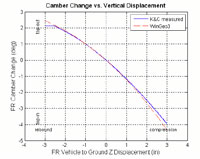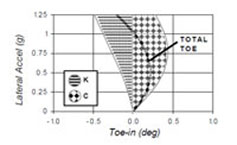
SAE Technical Articles
Interested in digging deeper into K&C testing? Check out these SAE technical articles authored or coauthored by our engineers:
Suspension Geometry: Theory vs. K&C Measurement
Automotive suspension geometry describes the kinematic movement of a car’s suspension based on a theoretical analysis of measured or designed points. This geometric analysis can be done with pencil and paper on a drawing board or with simple physical models, but is more commonly analyzed by the means of specialized software. By contrast, Kinematics and Compliance (K&C) machines measure suspension parameters as loads are applied to an existing chassis and vehicle suspension. This paper compares kinematic results based on measured points with those measured directly on a K&C test machine. This is an SAE technical paper available through the SAE web site.
Get the paper.
Using K&C Measurements for Practical Suspension Tuning and Development
In recent decades, suspension kinematics and compliance (K&C) testing has become a support-testing standard in the vehicle industry, providing invaluable data for suspension design and vehicle dynamics simulations. But in practical ride and handling tuning/development work, many readily available K&C test measurements have yet to achieve the empirical significance of traditional derived parameters such as roll center heights and roll stiffness distributions. In an attempt to emphasize the practical usefulness of K&C test data, this paper presents several methods by which this data can directly assist with chassis tuning and development. Traditional K&C data interpretation methods are discussed and new concepts such as “yaw efficiency” are developed and presented. This is an SAE paper available through the SAE web site.
Get the paper.
Interested in digging deeper into K&C testing? Check out these SAE technical articles authored or coauthored by our engineers:
Suspension Geometry: Theory vs. K&C Measurement
Automotive suspension geometry describes the kinematic movement of a car’s suspension based on a theoretical analysis of measured or designed points. This geometric analysis can be done with pencil and paper on a drawing board or with simple physical models, but is more commonly analyzed by the means of specialized software. By contrast, Kinematics and Compliance (K&C) machines measure suspension parameters as loads are applied to an existing chassis and vehicle suspension. This paper compares kinematic results based on measured points with those measured directly on a K&C test machine. This is an SAE technical paper available through the SAE web site.
Get the paper.
Using K&C Measurements for Practical Suspension Tuning and Development
In recent decades, suspension kinematics and compliance (K&C) testing has become a support-testing standard in the vehicle industry, providing invaluable data for suspension design and vehicle dynamics simulations. But in practical ride and handling tuning/development work, many readily available K&C test measurements have yet to achieve the empirical significance of traditional derived parameters such as roll center heights and roll stiffness distributions. In an attempt to emphasize the practical usefulness of K&C test data, this paper presents several methods by which this data can directly assist with chassis tuning and development. Traditional K&C data interpretation methods are discussed and new concepts such as “yaw efficiency” are developed and presented. This is an SAE paper available through the SAE web site.
Get the paper.
Get in touch:


Call Now: 704.638.6515
Call Now:
704.638.6515
1163 Speedway Blvd.,
Salisbury, NC 28146
Phone: 704.638.6515
Fax: 704.638.6516
Info@MorseMeasurements.com
© 2024 Morse Measurements | Powered by Miller Davis
1163 Speedway Blvd., Salisbury, NC 28146
Phone: 704.638.6515
Fax: 704.638.6516
Info@MorseMeasurements.com
© 2024 Morse Measurements | Powered by Miller Davis

